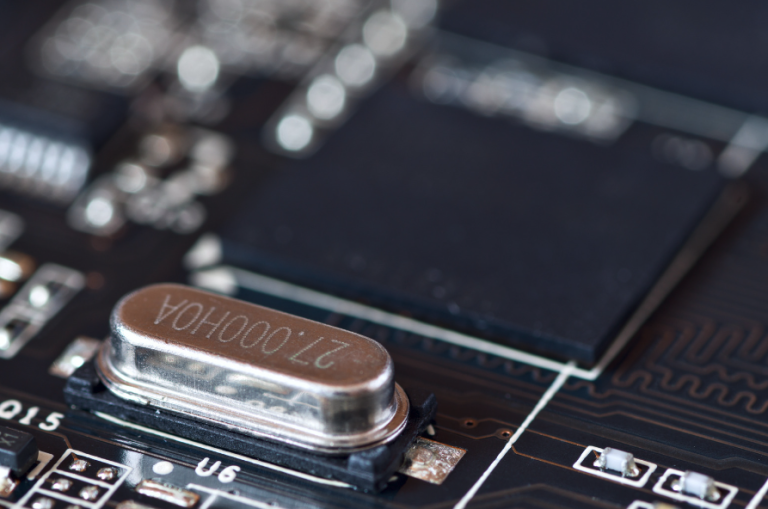What is an Oscillator? Functionality, Performance and Applications

More from the Category
Oscillators are essential components in the world of electronics, playing a crucial role in generating periodic signals. From the simplest applications to complex systems, oscillators provide the timing signals needed for synchronization and control. This article explains what oscillators are and how they work, explores the various types and their performance characteristics, highlights their applications across industries, and reviews recent advancements in this essential technology.
What is an Oscillator?
An oscillator is an electronic circuit that produces a continuous, periodic signal - typically in the form of a sine wave, square wave, or triangle wave - without requiring an input signal. These signals are defined by their frequency and amplitude, which can be precisely controlled to suit specific applications. In essence, an oscillator converts energy from a DC power supply into an AC signal.
Oscillators are found in a wide array of devices, including clocks, radios, and computers. They are considered the heartbeat of electronic systems, serving as timing references that enable circuits to synchronize and function properly.
Interested in other types of electronic components? Check out this Deep Dive into 14 Essential Components
What is an Oscillator in a CPU?
A CPU oscillator is responsible for generating clock signals that regulate the timing and speed of the processor. These clock signals synchronize various CPU components, allowing for the coordinated execution of instructions.
Typically, a crystal oscillator is used, which relies on the mechanical resonance of a vibrating quartz crystal to produce a stable frequency. This precise timing is critical to a CPU’s performance and efficiency, as it directly affects the instruction execution rate.
How Do Oscillators Work?
Oscillators generate a continuous, periodic signal - such as a sine wave or square wave - without requiring an input signal of the same frequency. They achieve this through the combined principles of feedback and resonance.
Basic Components
• Amplifier: Boosts the signal.
• Feedback Network: Determines the frequency of oscillation.
• Energy Source: Supplies power to sustain the oscillation.
The system continuously feeds part of its output back to the input, allowing the signal to regenerate itself. The frequency of oscillation depends on the configuration of components such as resistors, capacitors, and inductors within the feedback loop.
Purpose of an Oscillator
The primary purpose of an oscillator is to generate consistent clock signals that control the timing and synchronization of electronic systems, especially CPUs. These signals are essential for ensuring the coordinated execution of instructions, which in turn impacts overall system performance.
Types of Oscillators

Oscillators, essential components in electronic circuits, can be categorized based on the type of waveform they produce and their method of operation. These components are generally divided into two main categories.
Relaxation vs Linear Oscillators
Relaxation Oscillators: Produce non-sinusoidal waveforms such as sawtooth or square waves.
Linear Oscillators: Generate sinusoidal waveforms.
Specific Types
Crystal Oscillators: Crystal oscillators are linear oscillators, and use quartz crystals to generate precise frequencies. Known for their stability and accuracy, they are ideal for communication devices and clocks.
RC Oscillators: RC oscillators can be both relaxation oscillators and linear oscillators. These oscillators utilize resistors and capacitors to generate sine or square waves. Often used in audio applications due to their simplicity and cost-effectiveness.
LC Oscillators: LC oscillators are considered linear oscillators and use inductors (L) and capacitors (C) to produce oscillations. Typically employed in radio frequency (RF) applications due to their high-frequency capability.
Phase-Locked Loop (PLL) Oscillators: PLL oscillators are primarily considered linear oscillators and are used for frequency synthesis and modulation. Essential in telecommunications for signal processing and frequency control.
Emerging Oscillator Technologies
Recent advancements in oscillator technology focus on performance improvement, miniaturization, and integration with other electronic components.
MEMS Oscillators: Microelectromechanical systems offer smaller form factors, highly stable reference frequencies, and low power consumption - ideal for portable devices.
Programmable Oscillators: Allow for customized frequency outputs, reducing component count and streamlining the design process.
Devices That Use Oscillators
Many electronic devices rely on oscillators for essential functions like timing, signal generation, and frequency control. Their ability to produce consistent waveforms makes them indispensable in both consumer electronics and industrial systems.
Examples:
Quartz Watches: Use crystal oscillators to generate highly accurate timekeeping signals, ensuring the watch maintains precise seconds, minutes, and hours.
Radios: Rely on oscillators to generate carrier frequencies and to tune into specific broadcast channels for both AM and FM signals.
Computers: Employ oscillators in their system clocks to synchronize processor operations, manage data transfer, and maintain stable performance.
Cellphones: Utilize oscillators for network synchronization, frequency hopping in wireless communication, and internal clocking for processors and sensors.
Radar Systems: Depend on high-frequency oscillators to generate the radio waves that detect and measure the speed, range, and position of objects.
Metal Detectors: Use oscillators to produce electromagnetic fields that interact with metallic objects, enabling detection through changes in oscillation frequency or amplitude.
Performance Characteristics of Oscillators
Oscillators are evaluated based on several performance metrics that directly influence their suitability for specific applications. The three most critical are frequency stability, phase noise, and waveform shape.
Frequency Stability
Frequency stability describes an oscillator’s ability to maintain its output frequency under varying conditions over time.
- • Short-Term Stability: Covers rapid variations over seconds or minutes, often caused by noise or small environmental changes.
- • Long-Term Stability: Considers changes over hours, days, or years, typically influenced by component aging and gradual environmental shifts.
- • Environmental Factors: Temperature fluctuations, supply voltage changes, and mechanical vibrations can affect stability.
- • Crystal Oscillators: These oscillators excel in this area because the resonant frequency of a quartz crystal is highly resistant to such disturbances, making them ideal for precision timing applications like GPS, telecommunications, and laboratory measurement systems.
Phase Noise
Phase noise measures short-term, rapid fluctuations in the oscillator's phase, which manifest as small, random deviations from the ideal frequency.
- • It is usually represented as a power density (dBc/Hz) at a given frequency offset from the carrier signal.
- • Low Phase Noise: Essential in high-performance systems, such as satellite communications, radar, and high-speed data links, where timing jitter can degrade system performance or cause data errors.
- • High Phase Noise: Can lead to signal distortion, reduced sensitivity in receivers, and degraded performance in frequency synthesizers.
Waveform Shape
The oscillator’s output waveform determines how well it interfaces with downstream circuitry.
- • Sine Waves: Preferred in RF applications because they have minimal harmonic content, reducing the need for filtering.
- • Square Waves: Common in digital clocking applications, as their fast transitions make it easy for digital circuits to detect logic states.
- • Sawtooth or Triangular Waveforms: May be required in specialized systems, such as sweep generators in analog oscilloscopes.
- • Poor Waveform Shape: Can cause signal integrity issues, increased electromagnetic interference (EMI), or inaccurate timing in digital circuits.
Are Oscillators Active Components?
Oscillators are classified as active components. They amplify electrical signals and generate power, distinguishing them from passive components like resistors and capacitors. While oscillators incorporate passive elements in their circuits, their role in signal generation qualifies them as active devices.
Learn More: Exploring Passive and Active Electronic Components
Industries That Use Oscillators
Oscillators' ability to generate stable, precise signals makes them indispensable for timing, synchronization, and frequency control across a wide range of sectors. The specific oscillator type used often depends on the application's demands - whether it’s ultra-high precision, rugged durability, or low power consumption.
Telecommunications: Oscillators generate carrier signals for data transmission. Their stability and accuracy ensure signal integrity over long distances. Crystal and PLL oscillators are widely used here.
Consumer Electronics: Devices like smartphones and TVs rely on oscillators to generate clock signals for microcontrollers. Their precision directly impacts device performance.
Automotive: Used in engine control units, infotainment systems, and sensor applications (e.g., ABS), oscillators regulate timing for ignition and fuel injection.
Medical Devices: Essential in pacemakers and diagnostic tools, where reliability and precision are critical. Crystal oscillators are often chosen for their long-term stability.
Partner with Us
Understanding oscillators and their functions is essential for anyone working with electronic systems. They provide the timing signals that drive everything from processors to communication systems. With ongoing advancements such as MEMS and programmable oscillators, this technology continues to evolve - shaping the future of electronic design and innovation.
At Microchip USA, we’re here to help you source the right oscillator for your next project. With tens of millions of components supplied across various industries and a team of experts ready to assist, we’re your go-to partner for reliable component supply. Contact us today!









